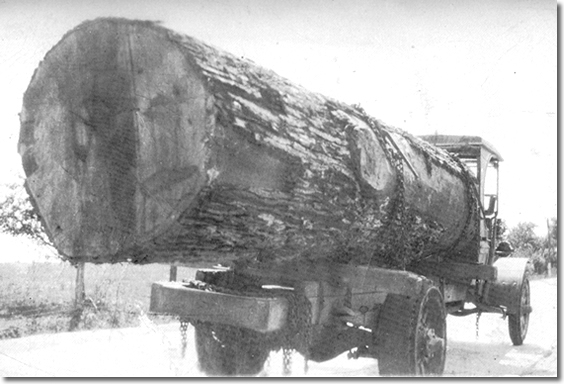|
The Big Log
by W. Dale Carter, copyright 2001, Kingsport, TN
“If you can haul it we can saw it”
In 1920, George Eastman purchased a wood-distillation plant in Kingsport, Tennessee, later known as Tennessee Eastman. The plant produced methanol, commonly referred to as wood alcohol, which was used in making film for Kodak. The hardwood forests in the area provided the timber used in the wood-distillation process to make the methanol. A band sawmill was operated by the company that sawed the prime timber into quality lumber; the lower grade timber was used as feed stock for the wood distillation plant.
Mr. Eastman employed A. J. White to oversee the timber operations of the fledgling chemical plant. Mr. Eastman acquired vast timber reserves in the area, but local timber men were contracted to supply timber as well. One of these timber men was Mr. Patton McNutt of Hiltons, Virginia. He and his three sons would cut timber from local property owners and haul the logs to Eastman’s band mill.
Mr. McNutt contacted Mr. White and told him he had purchased a huge white oak tree located at Indian Springs, Tennessee, and asked if he would be interested in buying the logs. Mr. White told McNutt that he would purchase the logs and if “he could haul it we can saw it”. This is the account of the saga as written by Lee McNutt, son of Patton McNutt.

“This tree was cut at Indian Springs, Tn. by the Weaver brothers in 1925 for Mr. Patton McNutt and his boys. It measured 8 feet in diameter and was 12 feet long. They were 1 ½ days cutting it down. Mr. A. J. White was contacted by phone about the log. Mr. White informed McNutt that he could saw anything he could bring to the band mill. It was loaded on a 2 ½ ton Bull Dog Mack Truck one evening and taking to TEC band mill. The following morning on entering the yard, Mr. Bradshaw came out and measured the log; it had 1,742 feet in it and would not let them unload it. Mr. White was called. He came over looked at it and offered Mr. McNutt $10.00 to move it off the log yard, which he refused and it was rolled off. Sometime later Mr. W. M. Hawk drilled holes in each end and used black power to split it into 4 pieces before it would go up the incline into the mill”.
Mr. White the great timber man from Michigan learned a valuable lesson that day. Never underestimate the capabilities of the local timber men from the hills of Southwest Virginia nd East Tennessee.
|
